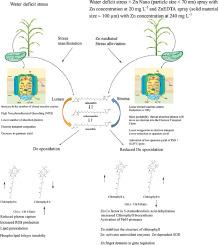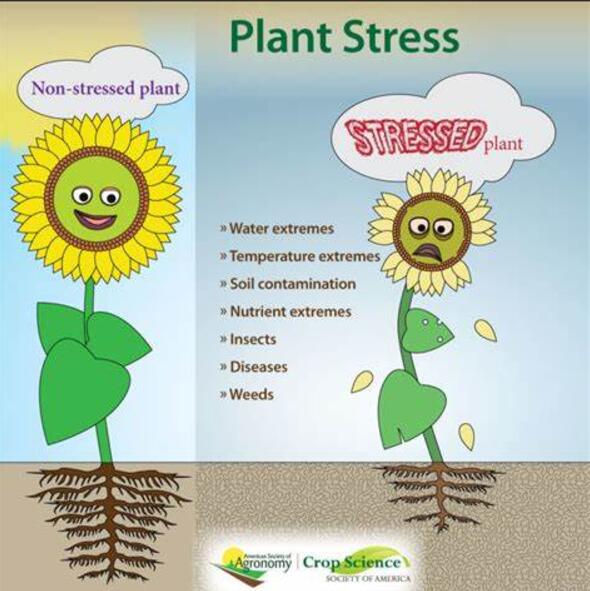纳米锌和乙二胺四乙酸锌(EDTA)介导的珍珠粟(Pennisetum glaucum (L.) R. Br.)缺水胁迫缓解:光系统 II 电子传递和色素动态
IF 6.8
Q1 PLANT SCIENCES
引用次数: 0
摘要
水分胁迫会对植物的光合装置和色素组成产生不利影响,导致产量降低和植物健康受损。纳米锌叶面喷施是改善缺水胁迫的潜在解决方案。在此,我们尝试通过研究叶绿素 a 快速荧光动力学和非光化学淬灭(NPQ)以及色素动态对水分胁迫的响应,详细剖析光系统 II(PSII)中的电子传递。我们还研究了这些过程可能发生的变化,以及纳米锌和乙二胺四乙酸锌(EDTA)叶面喷洒对其的调节作用,这可能会导致胁迫的改善。我们的研究结果表明,水分胁迫在光系统 II 的电子传输系统中造成了类似 "交通堵塞 "的情况,导致光合效率下降。缺水胁迫+纳米锌(粒径为 90 nm)喷雾(锌浓度为 20 mg L-1)和缺水胁迫+乙二胺四乙酸锌喷雾(固体物质粒径为 100 µm)(锌浓度为 240 mg L-1)的处理方法,通过对通量比参数(即:电子传递量子产率(μg/m2))的作用,有效地改善了缺水胁迫、电子传递量子产率(φE0)、电子传递超出 QA 的概率(ψ0)和电子从 QA 端传输到 PS1 端电子受体的量子产率(ϕR0),以及特定通量和现象通量。这些处理方法对叶绿素含量、黄绿素成分(包括小叶黄素、花青素和玉米黄素)有积极影响,并降低了 NPQ 和脱氧状态。较高浓度的纳米锌叶面喷洒剂(水胁迫+纳米锌喷洒剂 Zn @ 30 mg L-¹)对缺水胁迫的改善效果不如较低浓度的纳米锌叶面喷洒剂,尽管较高浓度的纳米锌叶面喷洒剂没有任何毒性。高浓度的纳米锌喷雾无法改善胁迫,这可能是由于锌元素在植物体内的生理作用受到了限制。我们的研究结果表明,最佳浓度的纳米锌和乙二胺四乙酸锌叶面喷洒剂能显著提高植物对水胁迫的适应能力。本文章由计算机程序翻译,如有差异,请以英文原文为准。

Zinc nano and zinc ethylenediaminetetraacetic acid (EDTA) mediated water deficit stress alleviation in pearl millet (Pennisetum glaucum (L.) R. Br.): Photosystem II electron transport and pigment dynamics
Water stress adversely affects the photosynthetic apparatus and pigment composition in plants, leading to reduced yields and compromised plant health. Zinc (Zn) foliar spray in nano form presents a potential solution to ameliorate water deficit stress. We attempt here a detailed dissection of electron transport in Photosystem II (PSII) through studies on chlorophyll a fast fluorescence kinetics and non-photochemical quenching (NPQ) and pigment dynamics in response to water stress. We also investigated the possible changes in these processes and the regulation of it by Zn Nano and Zn Ethylenediaminetetraacetic acid (EDTA) foliar sprays that may lead to amelioration of stress. Our results indicated that water stress created a "traffic jam" like situation in the electron transport system of Photosystem II, leading to decreased photosynthetic efficiency. Treatments with water deficit stress + Zn Nano (particle size < 90 nm) spray with Zn concentration at 20 mg L−1 and water deficit stress + Zn EDTA spray (solid material size ∼ 100 µm) with Zn concentration at 240 mg L−1 effectively ameliorated water deficit stress by its action on flux ratio parameters viz., quantum yield for electron transport (φE0), probability of electron transport beyond QA (ψ0) and quantum yield of electron transport from QA⁻ to PS1 end electron acceptors (ϕR0) and also the specific fluxes and phenomenological fluxes. These treatments positively influenced chlorophyll content, and xanthophyll components, including violaxanthin, antheraxanthin, and zeaxanthin, and reduced NPQ and the de expoxidation state. Higher concentrations of Zn Nano foliar spray (water stress + Zn Nano spray Zn @ 30 mg L⁻¹) did not ameliorate water deficit stress as effectively as the lower concentrations, although this higher concentration was not in any way toxic. This lack of stress amelioration at higher concentrations of Zn Nano spray may be due to physiological limitations of elemental zinc action within the plant. Our findings suggest that Zn foliar sprays in Nano and EDTA form at optimum concentrations can significantly improve plant resilience to water stress.
求助全文
通过发布文献求助,成功后即可免费获取论文全文。
去求助
来源期刊

Plant Stress
PLANT SCIENCES-
CiteScore
5.20
自引率
8.00%
发文量
76
审稿时长
63 days
期刊介绍:
The journal Plant Stress deals with plant (or other photoautotrophs, such as algae, cyanobacteria and lichens) responses to abiotic and biotic stress factors that can result in limited growth and productivity. Such responses can be analyzed and described at a physiological, biochemical and molecular level. Experimental approaches/technologies aiming to improve growth and productivity with a potential for downstream validation under stress conditions will also be considered. Both fundamental and applied research manuscripts are welcome, provided that clear mechanistic hypotheses are made and descriptive approaches are avoided. In addition, high-quality review articles will also be considered, provided they follow a critical approach and stimulate thought for future research avenues.
Plant Stress welcomes high-quality manuscripts related (but not limited) to interactions between plants and:
Lack of water (drought) and excess (flooding),
Salinity stress,
Elevated temperature and/or low temperature (chilling and freezing),
Hypoxia and/or anoxia,
Mineral nutrient excess and/or deficiency,
Heavy metals and/or metalloids,
Plant priming (chemical, biological, physiological, nanomaterial, biostimulant) approaches for improved stress protection,
Viral, phytoplasma, bacterial and fungal plant-pathogen interactions.
The journal welcomes basic and applied research articles, as well as review articles and short communications. All submitted manuscripts will be subject to a thorough peer-reviewing process.
 求助内容:
求助内容: 应助结果提醒方式:
应助结果提醒方式:


